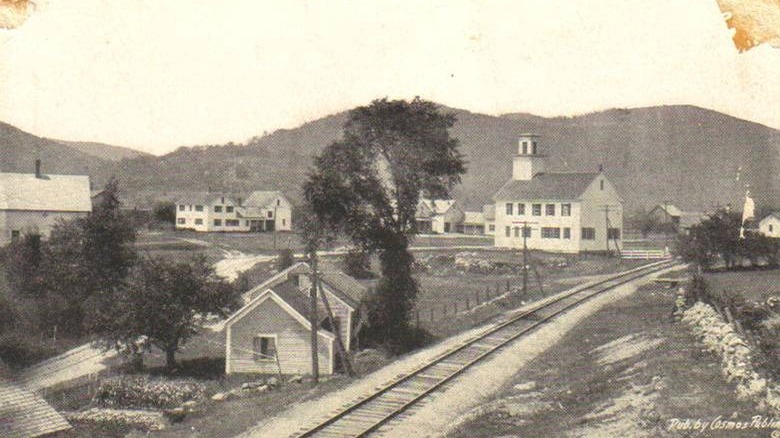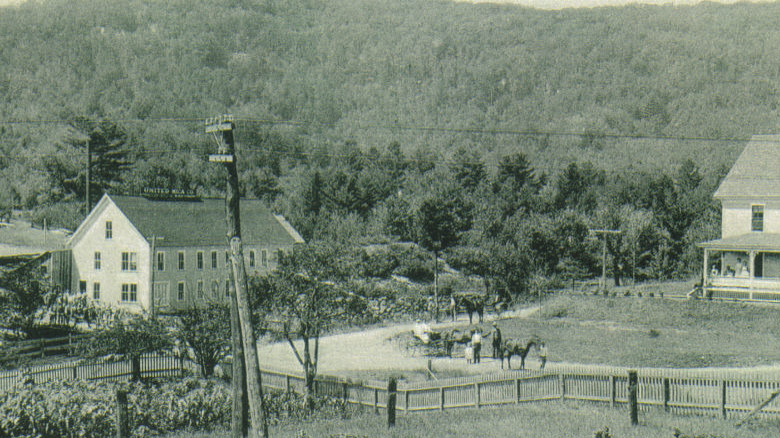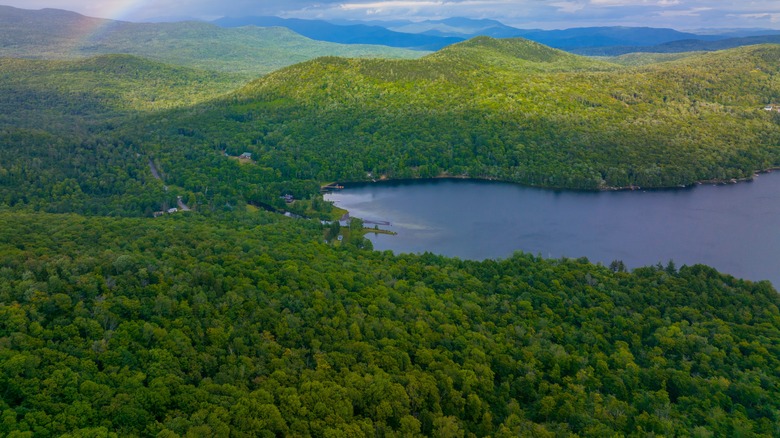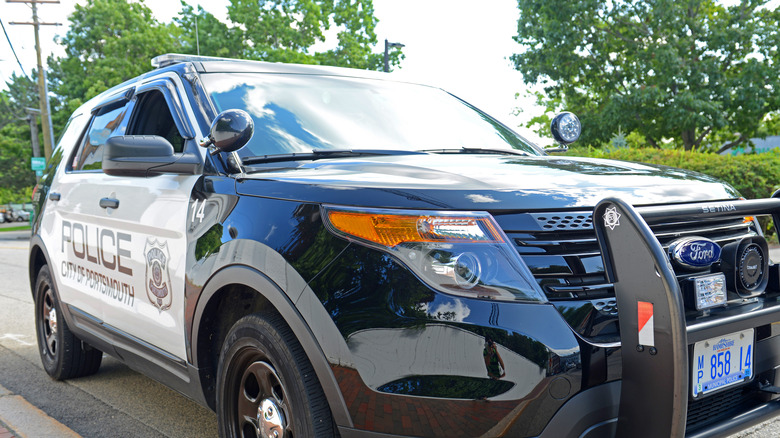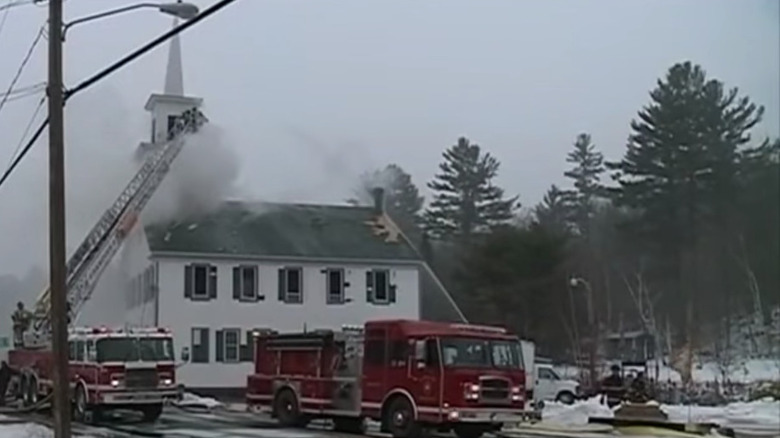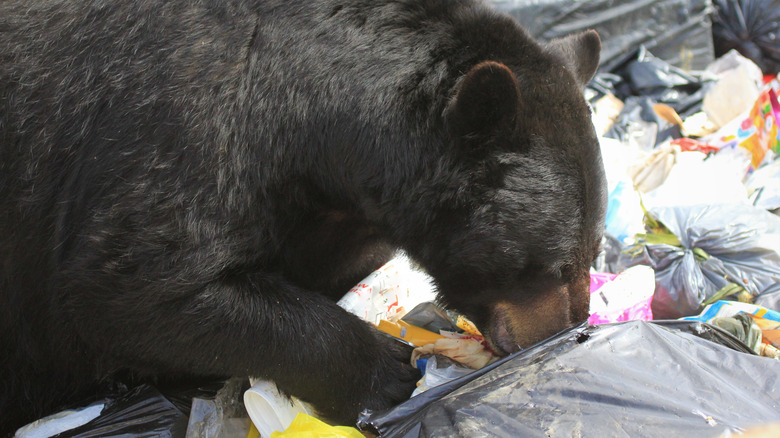The Disastrous Free Town Project Explained
In 2004, a group of extremist libertarians joined forces to take over a small town in New Hampshire. As described by Vox, the so-called "Free Town Project" was a social experiment designed to show the world what a society that was free from rules and regulations could look like. But ultimately, the Free Town Project was destroyed by something no one had planned for: bears.
Elizabeth Austin (via Washington Monthly), notes that the Free Town Project is symbolic of a larger fissure in American politics. Namely, a "disgruntled minority of Americans" strictly following the Declaration of Independence's list of rights without understanding "that these rights can exist only within the context of the social contract."
As described in an interview with journalist and author Matthew Hongoltz-Hetling, who has written extensively about the Free Town Project and authored a book on the subject, the "Free Towners" hoped that concentrating their voting power in a small area would allow them to transform it to align with their values. Hundreds of like-minded libertarians flocked to the tiny town of Grafton, New Hampshire in hopes of building a society that valued personal freedom above all else. The Grafton locals resisted, but the Free Towners were able to get enough legislation through to gut many of the town's most basic public programs. Then the bears came.
It began with the Free State Project
In 2001, a political science professor named Jason Sorens suggested a solution for libertarians who were frustrated by their inability to make an impact on American politics: Move to a small state and "take over the government."
As described by Mother Jones, at this time, the majority of libertarians thought the government was fundamentally wasteful and valued personal autonomy in everything from sexuality to drug use. Believers in Sorens' plan have argued for legalizing killing attackers in self-defense cases, banning vaccines in schools, cutting taxes, and basically deregulating whenever possible.
In the "Free State Project," as Sorens called it, a large group of people with similar libertarian views would move to an area, run for office, and swing the vote so that they could live in a place that was governed according to libertarian values. This was not the first time that the concept of a free libertarian utopia settlement had been suggested. Previous attempts, however, had mostly been established overseas (such as a South Pacific colony that was conquered by Tonga and a Haitian colony that was destroyed by a hurricane). Several regions were suggested for the Free State Project, but the libertarians ultimately decided they would try to take over New Hampshire.
Why Grafton, New Hampshire?
As stated by journalist and author Matt Hongoltz-Hetling in an interview with The Babylon Bee, there are currently no libertarian states or countries. The aim of the Free State Project was not only to create a utopia for libertarians to enjoy living in but also to create a tangible example of libertarian ideas in action. So in 2004, a group of individuals interested in this idea decided to plant new roots in a town called Grafton, New Hampshire.
New Hampshire seemed like a logical place to start because in some ways the state was already aligned with libertarian values and there are already plenty of weird state laws there. As explained by The New Republic, the town of Grafton had been opposing taxation for hundreds of years. The current population is small and eclectic, including followers of the Reverend Sun Myung Moon and homesteaders seeking a return to "New England's revolutionary days," per Hongoltz-Hetling (via The New Republic). The people of Grafton were also not particularly involved in local politics, which created an opportunity for the libertarians to step in. Most importantly, Grafton did not have restrictive zoning laws — something that would be fundamental to the Free Towners' plan.
Hundreds of Free Towners came to Grafton
The exact number of libertarians who moved to Grafton is unclear. Initially, some sources reported that it was as few as 50, but journalist and author Matt Hongoltz-Hetling stated in an interview with Vox that it was actually hundreds of people who moved to Grafton in hopes of creating a libertarian utopia.
While many libertarians were interested in the concept of the Free State Project, actually uprooting their entire lives to move to a small town in rural New Hampshire required a particularly dedicated individual. The majority of the Free Towners who moved to Grafton were white men who did not work regular 9-to-5 jobs or have families. Some were wealthy, which allowed them to relocate more easily. Most, however, were poor and did not have much holding them in their current homes and jobs.
Some of the Free Towners had more extreme views. According to The New Republic, one member of the group was the notorious Larry Pendarvis, who advocated for legalizing organ trafficking, dueling, and consensual cannibalism. As explained in Hongoltz-Hetling's book, "A Libertarian Walks Into a Bear: The Utopian Plot to Liberate an American Town (And Some Bears)" (via Valley News), Pendarvis arrived in New Hampshire under the pseudonym "Zack Bass," potentially to avoid connection to a previous child pornography conviction.
They didn't live in houses
The Free Towners were able to buy a large amount of land in Grafton for a relatively small amount of money, as explained by journalist and author Matt Hongoltz-Hetling in an interview with Vox. Houses were too expensive for all the new colonists to buy, and building that many homes was also a bigger undertaking than they were prepared to take on. So the Free Towners had to look toward "nontraditional housing."
According to Hongoltz-Hetling, one of the things that made Grafton so appealing to the Free Towners was its lack of zoning laws. Because there were not any laws preventing it, some new arrivals lived in yurts, cabins, and mobile homes, while others lived in shipping containers and tents. They embraced the unusual living situation as an expression of their personal freedom, with some even proudly referring to their new community as the "Tent City." However, "there was a lot of variation" in how this umbrella term of "personal freedom" was exercised, which would bring about problems down the line, according to Hongoltz-Hetling (via Vox).
The people of Grafton weren't happy
There were fewer than 1,000 people living in Grafton before the Free Towners arrived. As noted by journalist and author Matt Hongoltz-Hetling in an interview with Vox, these residents had no warning that their little town was about to become a political social experiment. As described by The New Republic, the Free Towners thought that the people of Grafton would be excited that their community was about to be transformed into a libertarian utopia. They were not.
A town meeting was called, which quickly turned into a town-wide argument. The locals of Grafton made it clear that they had no interest in having their home transformed for political reasons. When the townspeople started doing some research on the Free State Project and their new neighbors (including Larry Pendarvis), they were furious. Pendarvis was eventually forced out, but the damage had been done. The people of Grafton were unhappy that the Free Towners came into their town en masse and uninvited. Many were convinced that the newcomers would only cause problems.
The town started falling apart
The Free Towners were a minority in Grafton, but that didn't mean that they couldn't shake things up. As described by journalist and author Matt Hongoltz-Hetling in an interview with Vox, some of the Grafton townspeople were interested in cutting public services to save money. The locals were able to block some of the more extreme legislation — like pulling Grafton out of the local school system, canceling all road repairs, or declaring Grafton a "United Nations free zone" — but the Free Towners succeeded in getting enough residents on their side to cut funding for the fire department, police, and library.
According to The New Republic, the town had gone "feral" within a few years. As described by Hongoltz-Hetling, a major reason for this was that there were nonstop lawsuits between Grafton and the Free Towners, which cost a massive amount of money. An unusually large number of sex offenders moved to the largely unregulated town. The only police officer who worked in Grafton stopped responding to calls because his police cruiser needed repairs that the town would no longer pay for. Grafton's crime rates went way up, and there was even a double murder — the first ever recorded in Grafton.
The Free Towners established a church
Among the Free Towners was a man named John Connell. As stated in "A Libertarian Walks Into a Bear: The Utopian Plot to Liberate an American Town (And Some Bears)," Connell was a factory worker from Massachusetts. When he heard about the Free State Project, he relocated to New Hampshire and purchased the Grafton Center Church. He planned to live in the church and become its pastor while never having to pay taxes. Unfortunately, the building was poorly insulated and its furnace was not equipped to keep Connell warm in the cold New Hampshire winters.
Connell named his new home the "Peaceful Assembly Church," but not everyone in town agreed that it was a legitimate church at all. It wasn't affiliated with any known religion, but as noted by The New Republic, Connell was highly invested in securing tax exemption from the International Revenue Service (IRS) — even though he didn't think the IRS should have the right to grant tax exemption. Under Connell's care, the old meetinghouse was decorated with folk art, and he frequently gave fiery speeches from the pulpit about his beliefs.
As reported by WMUR, the Peaceful Assembly Church caught fire in 2016. The fire department did come, but firefighters had to wait hours before going inside because there were concerns that the building would collapse. Connell was killed in the fire, according to The New Republic.
The Free Towners accidentally attracted the bears
New Hampshire is home to many black bears, which typically don't cause problems for people living there. As described by New Hampshire Fish and Game, bear attacks are extremely rare: The last time someone was killed by a black bear in the state was 1784.
There's no way of knowing for sure exactly what made the bears around Grafton so different from other black bears, but as noted by The New Republic, something there seemed to be attracting them. One element was almost certainly the climate crisis, as the warmer winters interrupted their typical hibernation patterns and hot, dry summers meant their traditional food sources weren't available. It has been suggested that the Free Towners took over bear territory when they moved in and set up their tent cities. The bears may have developed toxoplasmosis infections from eating their trash, which could've been contaminated with pet waste.
In an interview with Vox, journalist and author Matt Hongoltz-Hetling suggested that the way that the Free Towners were living actually trained the bears to break into homes. The nontraditional houses set up by Free Towners were all different, including shipping containers, tents, and mobile homes. Each had different food inside and, because of the lack of regulations, people disposed of trash in different ways. The bears may have been attracted by the food and garbage and were further enticed by the challenge of figuring out how to break into each home.
Some Free Towners were feeding the bears
The disorganized camps in the wilderness around Grafton may have been attracting the bears unintentionally, but some Free Towners were attracting the bears on purpose. As reported by Matt Hongoltz-Hetling (via New Hampshire Magazine), there were more bears in every county than the government considered safe by 2018. In Grafton, the population was more than 50% higher than the recommended target.
In an interview with The Babylon Bee, Hongoltz-Hetling notes that some of the extreme libertarians felt that it was their right to feed the bears if they wanted to. Any attempts to stop them or put any restrictions on feeding the bears in place were considered government overreach.
In one peculiar situation, there was a dispute between a pair of neighbors (who were both elderly women) over the best way to handle the bears. One was extremely frightened of the bears and was armed at all times in case she ran into them. She would often stay indoors for hours after eating meat because she feared it would attract the bears. The other neighbor was intentionally feeding the bears and had been doing so for years. Twice a day, a group of bears would assemble outside her home and wait for her to feed them. She would provide them with two enormous buckets of grain, topped with an assortment of doughnuts.
People tried to fight the bears
One possible reason that the bears became aggressive is that humans became unpredictable. Some rewarded the bears with delicious treats, while others attacked them. As the number of bears in Grafton searching for food grew, some people tried to fight them. As described by Matt Hongoltz-Hetling in an interview with Vox, some Free Towners tried to deter bears that were looking for food by covering their garbage in cayenne pepper or setting up booby traps. Some tried to attack the bears, throwing firecrackers or firing their guns at any that they saw.
In the entire state of New Hampshire, there hadn't been a recorded bear attack in more than a century. But in 2012, a woman was attacked by a black bear in her own home. Soon, neighboring towns were also being affected by the unusually bold bears hunting for food, and there were two other bear attacks in the area. While these three people that were attacked by bears survived, they suffered severe injuries.
As noted by The New Republic, a group from Grafton once gathered together to attack the bears. One night, they went into the woods looking for bear dens. It is believed they illegally killed more than 12 bears. But this did not stop the bears from coming into Grafton.
The Free Town movement failed
As described in an interview with Matt Hongoltz-Hetling (via The New Republic), the survivalists in Tent City — originally seeking a life of freedom — ended up constructing a massive wall around their homes to keep bears out. While the bears essentially caged them in and ended the dream of the Free Town Project, the smaller movement has since been absorbed by the broader Free State Project that served as its inspiration in the first place. In 2016, approximately 20,000 individuals pledged to move to the state of New Hampshire with a similar goal. Although many of these pledges didn't play out, more than 6,000 Free Towners had moved to the state as of July 2022, per The New York Times.
Many have viewed the story of the failed Free Town as an amusing misadventure, but writer Elizabeth Austin (via Washington Monthly), points out that this story is symbolic of a larger problem in the United States. Citizens, losing faith in their government's ability to help them, cut public services and infrastructure in favor of personal freedom and lower taxes.
Since the three bear attacks near Grafton, New Hampshire, the town has considered several measures to reduce human-bear interactions, but they've had trouble passing any legislation. As reported by Matt Hongoltz-Hetling (via New Hampshire Magazine), a 2013 bill proposed installing bear-proof protections for all trash cans. For many of the residents, however, this was viewed as government overreach. Officials voted 14-0 to reject it.


